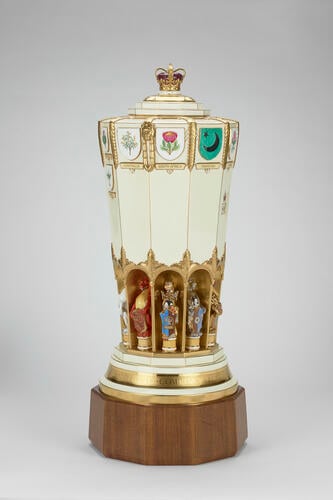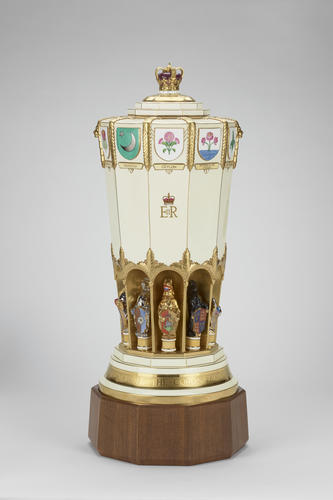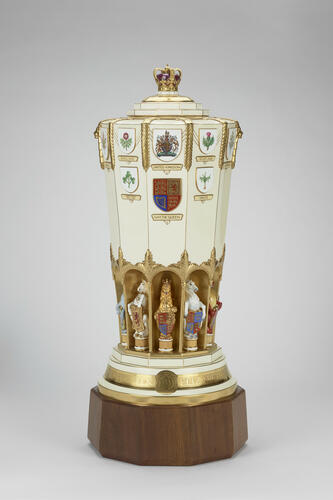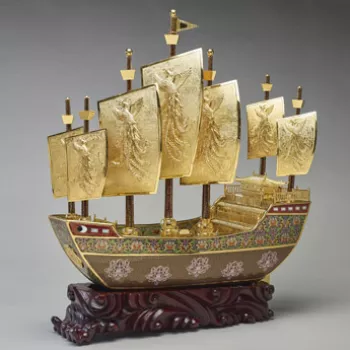The Queen's Vase 1953-54
Bone china, Australian blackbean wood | 75.5 x 32.6 x 31.5 cm (parts .a, .b and c together) | RCIN 57141
-
A pair of bone china commemorative vases, each of tapering decagonal form, surmounted by a cover with a crown finial. Each vase bears the emblems of the Commonwealth countries at the top, with a lower row of gilded niches housing the Queen's Beasts, with an inscription below. Each vase has a wooden base.
The modelling of the body of the vase took five months by Alan Moore, modeller at Mintons. Despite his 19 years of experience, the shape notoriously buckled in the kiln for many of the trials. The mould was made by George Heath of Mintons in plaster of Paris. There was difficulty extracting the vase from the mould because of the quantity of niches. The potted clay was dried slowly in room temperature. Three circular saggars were used to house each vase. The first biscuit firing was undertaken by Fred Arrowsmith, of over 50 years service at Mintons. Wedgwood specialists were brought in to advise on the distortion occuring to the shape.After two more firings and the spray application of the ivory ground glaze, floral emblems and coats-of-arms were printed from copperplates by the Mintons head engraver Frederick Ridgway, 48 years service. He spent an average of two days per week working on the individual emblems and described the creation of the United Kingdom and Scottish coats of arms as 'the most complicated task I have undertaken during my 48 years at Mintons'. The inscription on the base took six days to engrave and was applied by transfer printing. Gilding of the body was by William Key, 53 years service at Mintons.
John Wadsworth, designer, stated 'The idea came to me within ten minutes and the first drawing took only a week, but the vase itself is probably the most complicated design ever created in the history of bone china...This has been a wonderful opportunity to show the world that craftsmanship and craftsmen are still very much alive in the Potteries.' Other designers' work was considered, but Wadsworth as the art director and designer at Mintons, had the winning entry. The intention was to showcase the importance of the ceramics industry in England, both its history and its continuing importance both domestically and internationally.
From Pottery and Glass, July 1954, pp. 195-203.Provenance
One vase presented to Queen Elizabeth II at Buckingham Palace by the British Pottery Manufacturers' Federation to commemorate the Coronation, 14 July 1954; versions of the same vase were given to every Commonwealth country, the other vase in the Royal Collection being that presented to the nation of Scotland (which varies from the rest by having the Scottish crown to the reverse rather than the EIIR cipher, perhaps in acknowledgement that Queen Elizabeth II was not the second queen of that name in Scotland). An additional vase was made for presentation to the United States of America. The vases for Commonwealth countries were presented to the relevant High Commissioners by Princess Alice, Duchess of Gloucester and Field-Marshal Earl Alexander of Tunis at the Dorchester Hotel, London, 20 July 1954.
The presentation to Queen Elizabeth II were Mr J V Goddard, Coronation president, Mr A E Hewitt president, Mr F Shepherd Johnson, vice-president, Mr J R T Hay, deputy president, Colonel G A Wade, chairman of the Coronation Vase Committee, Mr W F Wentworth-Shields, director, Mr John Wadsworth, designer.
The home nations vases were sent to the Tower of London (England); the Palace of Holyroodhouse (Scotland, remains in the Royal Collection as RCIN 57141.2 although no longer in Edinburgh), Stormont (Northern Ireland) and the National Museum of Wales.
The British Pottery Manufacturers Federation (subsequently the British Ceramic Manufacturers' Federation) came into existence in 1919 and continued to trade until early 1995 when the company was dissolved as a result of its activities becoming fully incorporated within the British Ceramic Confederation. -
Creator(s)
(porcelain manufacturer)(nationality)(designer)Acquirer(s)
-
Medium and techniques
Bone china, Australian blackbean wood
Measurements
75.5 x 32.6 x 31.5 cm (parts .a, .b and c together)
Category












